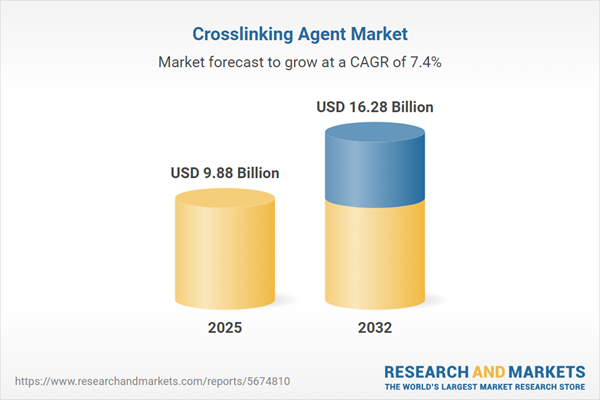Speak directly to the analyst to clarify any post sales queries you may have.
The Crosslinking Agent Market is poised for sustained expansion, supported by advances in polymer science and shifting industry needs. Stakeholders in sectors such as automotive, construction, and medical devices increasingly rely on high-performance crosslinking chemistries to enhance product durability, efficiency, and compliance with evolving standards.
Market Snapshot: Growth Trajectory of the Crosslinking Agent Market
The crosslinking agent market grew from USD 9.22 billion in 2024 to USD 9.88 billion in 2025, and is expected to reach USD 16.28 billion by 2032, with a CAGR of 7.35%. This robust growth reflects expanding adoption across end-use sectors, driven by the demand for advanced polymers with improved mechanical, thermal, and chemical properties. Regulatory shifts and consumer expectations are further influencing the push towards sustainable formulations and energy-efficient processing technologies.
Scope & Segmentation: Comprehensive Landscape Analysis
This report offers a detailed review of the crosslinking agent landscape, analyzing critical segments by chemistry, application, function, substrate, and region, as well as company strategies and supply chain trends.
- Type: Amines (aliphatic, aromatic), carbodiimides, epoxies/epoxy hardeners, isocyanates, maleic anhydride, melamine formaldehyde, metal catalysts, phenolic resins, sulfur.
- Function: Chemically cured, free radical crosslinkers, ionic crosslinkers, moisture-cured, photo-initiated (UV), radiation-cured, self-crosslinking agents, thermal crosslinkers.
- Substrate: Adhesives & sealants, coatings & paints (powder, solvent-based, water-based), foams, inks & printing systems, polymers/plastics (acrylic, epoxy, polyethylene, polypropylene, polyurethane, polyvinyl chloride, silicone rubber), rubber/elastomers (natural, synthetic), textiles/fibers.
- Application: Adhesives & sealants, construction, electronics, healthcare/medical devices, packaging, paints & coatings, plastics & polymers processing, rubber & tire manufacturing, textiles.
- Distribution Channel: Offline, online.
- Regions: Americas (United States, Canada, Mexico, Brazil, Argentina, Chile, Colombia, Peru), Europe, Middle East & Africa (United Kingdom, Germany, France, Russia, Italy, Spain, Netherlands, Sweden, Poland, Switzerland, United Arab Emirates, Saudi Arabia, Qatar, Turkey, Israel, South Africa, Nigeria, Egypt, Kenya), Asia-Pacific (China, India, Japan, Australia, South Korea, Indonesia, Thailand, Malaysia, Singapore, Taiwan).
- Companies: Aditya Birla Group, Allnex GMBH, 3N composite products LLP, AkzoNobel N.V., Arkema Group, BASF SE, Covestro AG, DuPont de Nemours, Inc., Eastman Chemical Company, Evonik Industries AG, Hexion Inc., Huntsman International LLC, Incorez Ltd., INEOS AG, Kuraray Co., Ltd., LANXESS AG, Luxfer MEL Technologies, Merck KGaA, Nagase America LLC, Nanjing SiSiB Silicones Co., Ltd., Otto Chemie Pvt. Ltd., Qingdao Enze Chemical Co., Ltd., Stahl Holdings B.V., Super Urecoat Industries, Wacker Chemie AG.
Key Takeaways for Senior Decision-Makers
- Innovation in crosslinking chemistries now focuses on achieving sustainability, precision curing, and minimized by-product formation, directly addressing contemporary regulatory and end-user demands.
- Sector-specific adoption is shaped not only by performance requirements but also by interplay between agent chemistry and polymer compatibility, impacting formulation strategies and market differentiation.
- The evolution from general-purpose to application-specific solutions is accelerating, especially in sectors like automotive, packaging, and healthcare, where unique attributes such as antimicrobial effects or low-temperature curing are crucial.
- Geographical demand is influenced by infrastructure investment and the regulatory climate, with strong competition arising in Asia-Pacific, efficiency-driven upgrades in the Americas, and green-compliance trends in Europe, Middle East, and Africa.
- Partnerships, acquisitions, and alignment with OEMs and research organizations are reshaping the competitive landscape, enabling agile responses to technological and market shifts.
Tariff Impact: Navigating the 2025 Regulatory Climate
The introduction of new U.S. tariff structures in 2025 introduced cost pressures and required supply chain adaptation, notably for imports of specialized isocyanates. These changes spurred manufacturers to pursue sourcing agreements with domestic and proximate suppliers, shift to alternative chemistries, and reexamine pricing models. Strategic resilience in supply and risk management has become increasingly critical amid this evolving tariff environment.
Methodology & Data Sources
This analysis synthesizes quantitative and qualitative insights from primary interviews with manufacturers, technology providers, and end-users. Secondary sources include peer-reviewed literature, industry reports, and regulatory documents. Triangulation and case studies ensure robust market forecasts and actionable segmentation.
Why This Report Matters to Stakeholders
- Enables strategic investment in the most promising technologies and segments, grounded in comprehensive market segmentation and regional insights.
- Facilitates proactive response to evolving tariff, regulatory, and sustainability requirements in sourcing and formulation decisions.
Conclusion
By leveraging this report, leaders can refine growth strategies, build supply chain resilience, and capitalize on emerging opportunities within the crosslinking agent market.
Additional Product Information:
- Purchase of this report includes 1 year online access with quarterly updates.
- This report can be updated on request. Please contact our Customer Experience team using the Ask a Question widget on our website.
Table of Contents
3. Executive Summary
4. Market Overview
7. Cumulative Impact of Artificial Intelligence 2025
List of Figures
Samples

LOADING...
Companies Mentioned
The key companies profiled in this Crosslinking Agent market report include:- Aditya Birla Group
- Allnex GMBH
- 3N composite products LLP
- AkzoNobel N.V.
- Arkema Group
- BASF SE
- Covestro AG
- DuPont de Nemours, Inc.
- Eastman Chemical Company
- Evonik Industries AG
- Hexion Inc.
- Huntsman International LLC
- Incorez Ltd.
- INEOS AG
- Kuraray Co., Ltd.
- LANXESS AG
- Luxfer MEL Technologies
- Merck KGaA
- Nagase America LLC
- Nanjing SiSiB Silicones Co., Ltd.
- Otto Chemie Pvt. Ltd.
- Qingdao Enze Chemical Co., Ltd.
- Stahl Holdings B.V.
- Super Urecoat Industries
- Wacker Chemie AG
Table Information
| Report Attribute | Details |
|---|---|
| No. of Pages | 182 |
| Published | October 2025 |
| Forecast Period | 2025 - 2032 |
| Estimated Market Value ( USD | $ 9.88 Billion |
| Forecasted Market Value ( USD | $ 16.28 Billion |
| Compound Annual Growth Rate | 7.3% |
| Regions Covered | Global |
| No. of Companies Mentioned | 26 |









